According to the Encyclopaedia Britannica, the germ “theory” of disease, which states that certain diseases are caused by the invasion of the body by microorganisms too small to be seen, has “long been considered proved.” Harvard University says that the “theory” was “developed, proved, and popularized in Europe and North America between about 1850 and 1920.” Wikipedia claims that the germ “theory” of disease is “the currently accepted scientific theory for many diseases.” Papers published in scientific journals claim that Louis Pasteur and Robert Koch “firmly established the germ theory of disease” and that they “first proved the germ theory of disease in the second half of the nineteenth century.” Thus, if we were to listen to what the mainstream sources declare, it would appear that the germ “theory” of disease has been scientifically proven based upon the evidence established by Louis Pasteur and Robert Koch. We are to believe that the work of these two men allowed for the initial germ hypothesis to be “proven” in order to be elevated to the status of a scientific theory. However, is that truly the case? Did Pasteur and Koch provide the necessary scientific evidence required in order to confirm the germ hypothesis? What does it take to accept or reject a hypothesis? How does a hypothesis go on to become a scientific theory? In the first of a two-part examination of the germ hypothesis looking at the work of both men, we will begin by inspecting two of Pasteur’s early attempts to prove his hypothesis in the cases of chicken cholera and rabies. We will investigate how he arrived at his germ hypothesis, and then look to see if his experimental evidence reflected anything that could be witnessed in nature. In doing so, we will find out whether or not Louis Pasteur was ever able to validate and confirm his germ hypothesis.
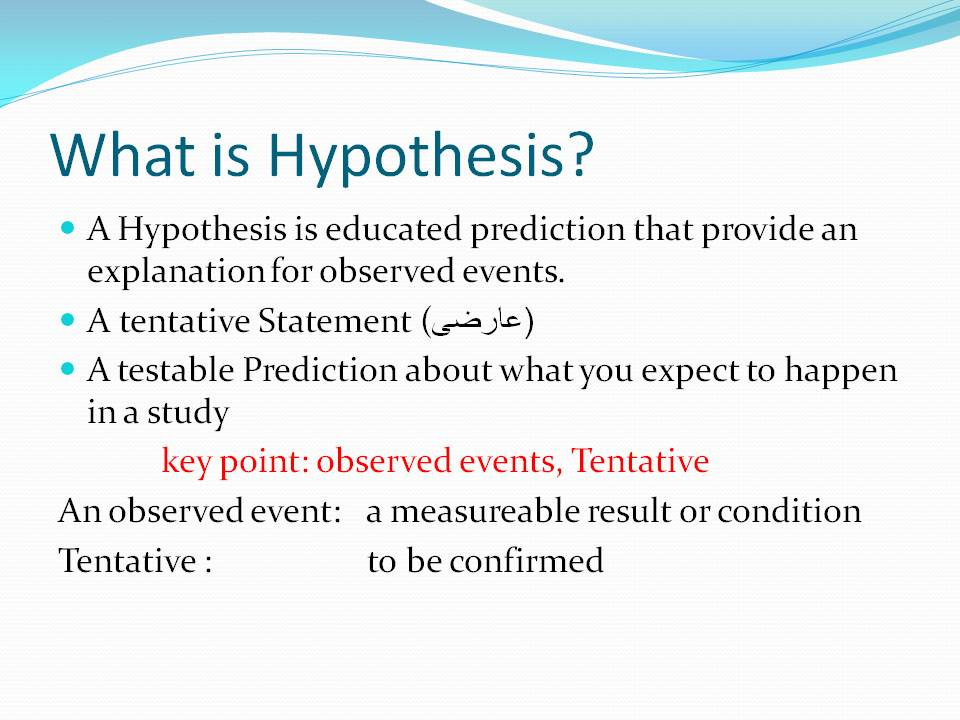
What is a Hypothesis?
To begin this investigation, we need to understand what exactly a hypothesis is supposed to be. Returning to the Brittanica for a moment, a scientific hypothesis is defined as “an idea that proposes a tentative explanation about a phenomenon or a narrow set of phenomena observed in the natural world.” Stated in another way, a hypothesis is an explanation based upon and about an observed natural phenomenon. However, what exactly is a natural phenomenon in relation to natural science? According to the Next Generation Science Standards (NGSS), a natural phenomena is defined as “observable events that occur in the universe and that we can use our science knowledge to explain or predict.” This definition by the NGSS was developed from a 26 state effort that created new education standards in science in collaboration with the National Science Teachers Association (NSTA), the American Association for the Advancement of Science (AAAS), the National Research Council (NRC), and the nonprofit organization Achieve. Supporting the NGSS definition of natural phenomena as being observable events are various philosophers of science, such as Ian Hacking, considered the first to define phenomena from the scientists perspective, who stated that a phenomenon is “commonly an event or process of a certain type that occurs regularly under definite circumstances. The word can also denote a unique event that we single out as particularly important.” Michela Massimi, another philosopher of science, agreed with Hacking in her book Perspectival Realism, stating that “phenomena are events: they are not things, entities, structures, facts, or states of affairs.” Thus, from these definitions, we can narrow down natural phenomena to observable events (or processes). Nonetheless, not just any event will do. In order for a phenomenon to be natural, these events must occur in nature without human influence and interference. In other words, the events are not man-made. If these conditions are met and a natural phenomenon is observed, a proposed explanation can be formulated in order to try and describe what might be occurring.
The Britannica goes on to state that two very important and primary features of a scientific hypothesis are falsifiability and testability. Falsifiability means that the hypothesis is stated in such a way that there is some capacity to be able to prove the hypothesis wrong through experimentation. This idea was introduced by scientific philosopher Karl Popper in 1935 in his book The Logic of Scientific Discovery. According to this concept, someone should be able to conceivably design an experiment that could prove the hypothesis wrong. If a hypothesis is capable of being proven wrong, and yet it is supported by experimental evidence of its truth, then it can be considered as a scientific hypothesis. A falsifiable hypothesis should be formulated as an “If…then” statement that summarizes the idea established from the phenomenon, and it must have testability, meaning that it can then be supported or refuted through experimentation.
The observation of a natural phenomenon and the creation of a falsifiable and testable hypothesis is the first part of the scientific method, as noted in Chapter 2 ~ Science as a Way of Understanding the Natural World of the book Environmental Science.
“The scientific method begins with the identification of a question involving the structure or function of the natural world, which is usually developed using inductive logic (Figure 2.1). The question is interpreted in terms of existing theory, and specific hypotheses are formulated to explain the character and causes of the natural phenomenon.”
“In contrast, a hypothesis is a proposed explanation for the occurrence of a phenomenon. Scientists formulate hypotheses as statements and then test them through experiments and other forms of research. Hypotheses are developed using logic, inference, and mathematical arguments in order to explain observed phenomena.”
According to Elsevier, a Dutch academic publishing company specializing in scientific, technical, and medical content, without a hypothesis, there can be no basis for a scientific experiment. We can therefore conclude that the hypothesis is crucial to obtaining scientific evidence. They state that the hypothesis is “a prediction of the relationship that exists between two or more variables.” What this means is that a hypothesis must be designed and written in such a way as to “prove” whether or not a predicted relationship derived from the natural phenomenon exists between two variables: the independent variable (the presumed cause) and the dependent variable (the observed effect).
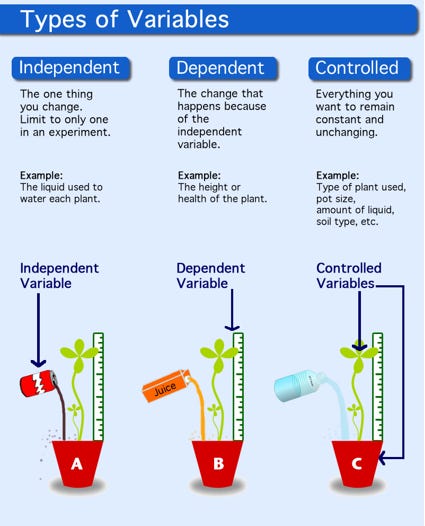
This is usually then stated as the null hypothesis, which predicts that there is no relationship between the variables, and as the alternative hypothesis, which predicts that there is a relationship between the variables.
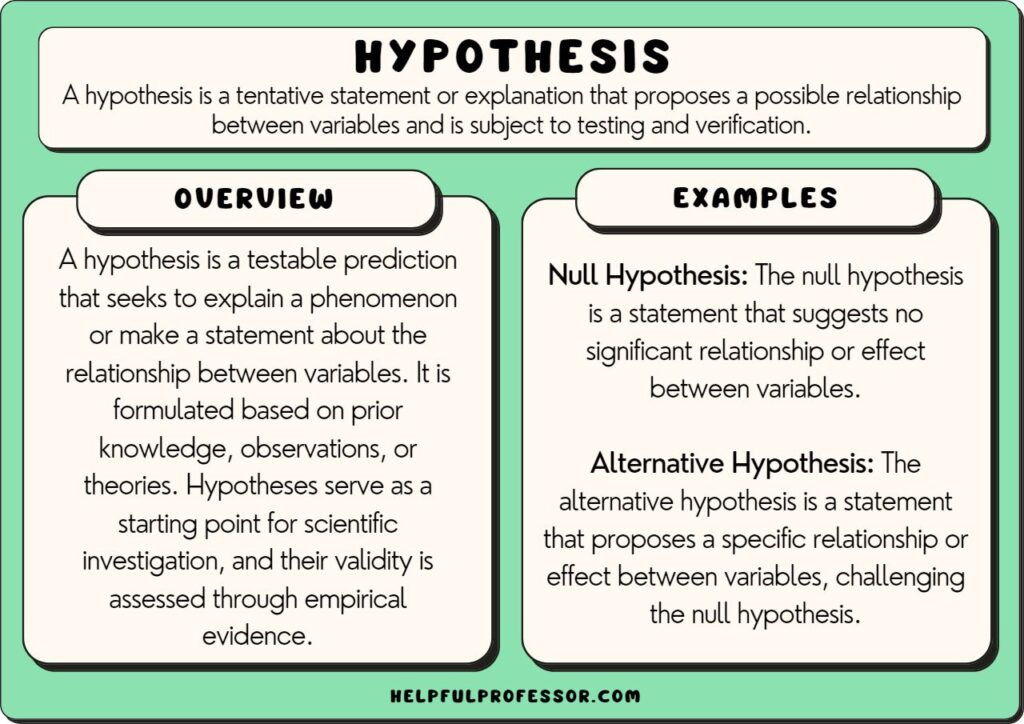
Once the hypothesis has been established, a proper experiment can be designed in order to test it. According to American philosopher and historian of science Peter Machamer in his 2009 paper Phenomena, data and theories: a special issue of Synthese, the experiment should show us something important that occurs within the real world. The goal is to ensure that the aspects of the observed natural phenomenon that originally sparked the hypothesis are “caught” in the design of the experiment. In this way, the experiment will be able to tell us something about the world and the phenomena studied. Thus, it is critical that the hypothesis is tested properly through an experimental design that accurately reflects the observed natural phenomenon and what is seen in nature.
Does the experiment actually show us something important about what is going on in the real world that lies outside of the experimental setting? One form of this worry is gleaned by making a distinction between phenomena and artifacts (see Feest 2003, 2005, 2008). This problem arises when operationalizing a phenomenon so it may be experimentally investigated in a laboratory or other non-natural setting. Basically, we want to make sure that when we create an experimental design, we are reasonably sure that we are ‘catching’ the aspects of the phenomenon that originally sparked our interest or which we were seeking to explain. We want our experiments to tell us something about the world, about the phenomena. When we design experiments we try to simplify situations so that we may control the relevant variables, which will then allow us to intervene and observe what happens as a result of the intervention. We design experiments to generate data, which then may be used to tell us something about how the world is or how it works. But often we know something about the phenomenon of interest before setting up the experiment.”
If the hypothesis is tested correctly through proper experimental design via the scientific method, and repeated testing strengthens the correlation between two or more things happening in association with each other resulting in the observed natural phenomenon, the cause of a natural phenomenon can be proven. This would make it possible to determine the likelihood of the event happening again. If the results are confirmed through replication and reproducibility by independent researchers, this gives the hypothesis predictive power. Once the predictions provided by the hypothesis are repeatedly confirmed through independent verification and validation by the scientific community, the hypothesis can then be elevated to a scientific theory.
However, to get to the point of becoming a scientific theory, the hypothesis must be confirmed through accurate experimentation first, and it must not be falsified. This absolutely critical fact is seemingly something that was forgotten when the germ hypothesis was elevated to the status of a scientific theory. As Albert Einstein stated, “No amount of experimentation can ever prove me right; a single experiment can prove me wrong.” What does it say about the evidence supporting a hypothesis if the experiments designed reflecting the hypothesis failed, and the evidence obtained that “supports” it was through experiments that were not designed properly and do not reflect the proposed explanation? If the experiments do not reflect the hypothesis that was derived from the observed natural phenomenon, can the knowledge acquired still be considered scientific knowledge that tells us anything truthful about what really occurs in nature? With these questions in mind, let’s see if Louis Pasteur’s hypotheses hold up under scrutiny.
Creating the Germ Hypothesis
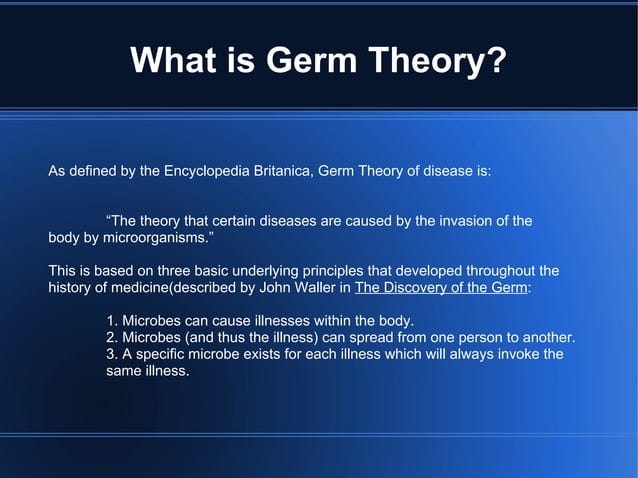
According to French-American microbiologist Rene Dubos, the “central dogma of the germ theory is that each particular type of fermentation or of disease is caused by specific a kind of microbe.” While the idea that disease could be caused by invisible germs had been around since Girolamo Fracastoro published De Contagione et Contagiosis Morbis in 1546, French chemist Louis Pasteur conjured up his own germ hypothesis in the early 1860s based upon his work on fermentation. Granted, Pasteur had largely plagiarized from the work of French chemist and physician Antoine Bechamp, which he subsequently misinterpreted as Bechamp saw the microbes, which he referred to as microzymas, performing a necessary and vital function by breaking down substances and tissues in order to carry away dead cells and other waste products. In other words, germs are nature’s clean-up crew and are not the cause of disease. As he noted in The Blood and its Third Anatomical Element, Bechamp viewed these processes as being born within all living things based upon the internal environment of the individual:
“The bacteridiae were not the cause of the diseased condition, but were one of its effects; proceeding from the morbid microzymas they were capable of inducing this diseased condition in the animal whose microzymas were in a condition to receive it. Hence it is seen that the alteration of natural animal matters is spontaneous, and justifies the old aphorism so concisely expressed by Pidoux: “Diseases are born of us and in us.”
“On the other hand, the disregard of this law of nature, the firm establishment whereof is completed by the present work, necessarily led M. Pasteur to deny the truth of the aphorism, and to imagine a pathogenic panspermy, as he had before conceived, a priori, that there was a panspermy of fermentations. That M. Pasteur after having been a sponteparist should reach such a conclusion was natural enough; he was neither physiologist nor physician, but only a chemist without any knowledge of comparative science.”
Pasteur, on the other hand, viewed the germs, such as yeasts involved in the fermentation of sugar to produce alcohol as well as other microbes responsible for putrefaction and the decay of tissues, as outside invaders. He proclaimed that the microbes, isolated from wounds and other degenerative tissues, were the cause of the destruction of the normal tissues, leading to disease. His views ran contrary to the popular notion at the time that microbes were the result of, and not the cause of, disease. Pasteur, along with a minority of other scientists, believed that diseases arose from the activities of these microorganisms, while opponents such as Bechamp and German pathologist Rudolf Virchow, believed that diseases arose from an imbalance in the internal state of the afflicted individual. As noted by Bechamp, just as Pasteur had assumed that there was a specific microbe for each ferment, he did the same by assuming that this must hold true for human and animal diseases as well.
However, there was a bit of a problem for the germ hypothesis as Pasteur was unable to ever observe any germ “infecting” anyone in order to cause disease. The only natural phenomenon that he could observe were the signs and symptoms of disease, and he tried to correlate a tentative relationship between microbes and disease based upon finding microbes in wounds and diseased tissues. As we know, correlation does not equal causation. The fact that microbes are found on the body of a decaying animal does not mean that the microbes caused the animal to die. The microbes occur after the fact in order to perform a necessary function, in this case decomposition. Rather than concluding that the microbes were present in wounds due to the need to heal the injury, Pasteur assumed that the microbes, which he claimed were present all around us within the air, became attracted to the wounds, taking advantage of the weakened state. With this a priori assumption in mind, Pasteur set out to create evidence to support his preconceived idea.
Testing the Germ Hypothesis
Chicken Cholera
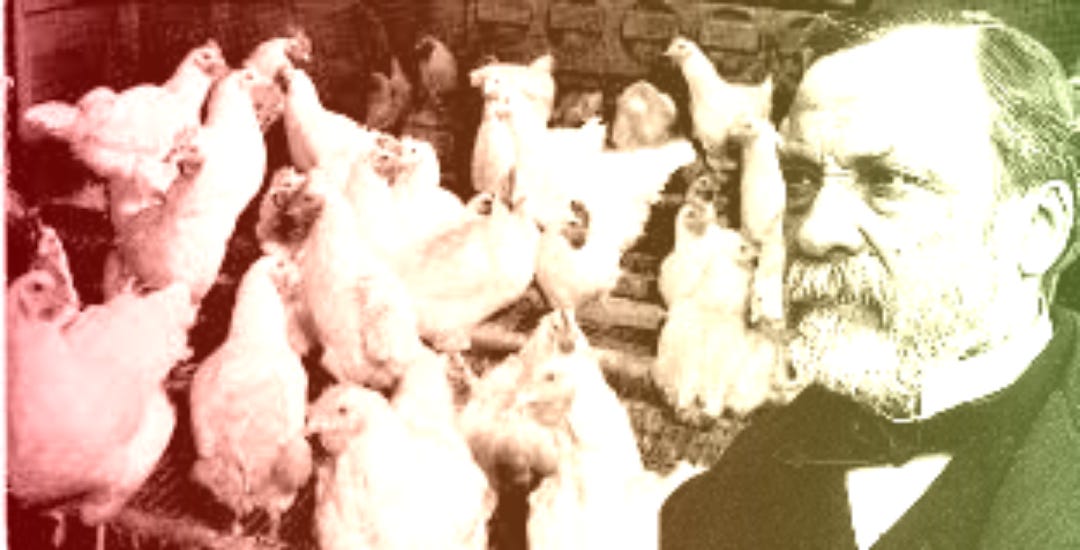
While Pasteur had this idea of how diseases were caused by microorganisms as early as the 1860s, he didn’t put his hypothesis to the test until the late 1870s. In an 1878 lecture The Germ Theory And Its Applications To Medicine And Surgery read before the French Academy of Sciences on April 29th, 1878, Pasteur had already hypothesized that there was a “virus” (i.e. some form of chemical poison as the word didn’t mean an obligate intracellular parasite at that time) in the solutions of the bacterial cultures that he was working with. He then went on to claim that this poison would accumulate within the body of the animal as the bacteria grew. Interestingly, he then noted that his hypothesis presupposes the forming and necessary existence of the bacteria, thus admitting that his hypothesis was not based upon any observed natural phenomenon.
“There is only one possible hypothesis as to the existence of a virus in solution, and that is that such a substance, which was present in our experiment in nonfatal amounts, should be continuously furnished by the vibrio itself, during its growth in the body of the living animal. But it is of little importance since the hypothesis supposes the forming and necessary existence of the vibrio.”
Regardless, Pasteur’s attempts to prove his germ hypothesis began later that same year with his study into the fowl disease known as chicken cholera. According to Gerald Geison’s The Private Science of Louis Pasteur, in December of 1878, Pasteur was supplied some blood from a diseased chicken by Henri Toussaint, a French veterinarian who claimed to have cultured the responsible bacterium. However, another version states that Toussaint sent the heart of a guinea pig inoculated with the presumed germ of chicken cholera to Pasteur. Whatever the case, Pasteur immediately attempted isolating the microbe in a state of “purity” in order to demonstrate that it was the sole cause of chicken cholera. Upon doing so, he realized that the microbe developed more easily in neutral chicken broth than in the neutral urine that Toussaint utilized as his culture medium. While Pasteur thanked Toussaint, Geison noted that he “left little doubt that he considered Toussaint’s work and techniques decidedly inferior to his own.” Pasteur eventually claimed that he could make successive cultures of what he referred to as the “virus” (i.e. poison) always in a state of “purity” in a medium of chicken broth from diseased chickens. He would then use this to inoculate healthy chickens and cause disease.
In his 1880 paper Sur les maladies virulentes et en particulier sur la maladie appelée vulgairement, Pasteur laid out his hypothesis on how he felt that the disease spreads. After unsuccessful attempts to make guinea pigs sick utilizing the cultured “organism,” he assumed that guinea pigs could become “infected” but were essentially “immune” besides the formation of abscesses. He assumed that the pus in abscesses left after injection contained the microbe responsible for the disease in a “pure state.” Pasteur then hypothesized that these pustules would burst open and spill the bacterial contents onto the food of the chicken and rabbits, contaminating them and causing disease.
“Inoculation of this organism to guinea pigs is far from bringing death as surely as with hens. In guinea pigs, especially of a certain age, we do not observe that a local lesion at the point of inoculation, which ends in a more or less large abscess. After opening spontaneously, the abscess closes and heals without the animal having stopped eating and to have all the appearances of health.”
“Chickens or rabbits that would live in company of guinea pigs with such abscesses could suddenly become ill and perish without the health of the guinea pigs appearing less altered in the world. For this, it would be enough for the abscesses of the guinea pigs, having just opened, spill a little of their contents on chicken and rabbit feed. An observer, witness to these facts and ignoring the filiation of which I speak, would be in astonishment to see chickens and rabbits decimated, without apparent causes, and would believe in the spontaneity of evil, because it would be far from supposing that it took its origin in guinea pigs, all healthy, especially if he knew that guinea pigs are also subject to the same affection.”
Clearly, Pasteur’s hypothesized exposure route of contaminated food covered in guinea pig pustules was not based upon any observed natural phenomenon. It was an idea that he conjured up after his failed attempts to make guinea pigs sick. There was no attempt to recreate this hypothetical scenario in Pasteur’s 1880 paper The Attenuation of the Causal Agent of Fowl Cholera. There is also no mention as to the exact details of his culturing methods or how the chickens were actually inoculated in order to recreate his presumed exposure route. While there are sources that claim that he fed the chickens the bacterium, others say that the chickens were injected. The only mention of the chickens being fed anything that I could find came from a paper that Pasteur published in 1881 titled On Chicken Cholera: Study of the Conditions of Non-Recidivation and of Some Other Characteristics of This Disease. In it, Pasteur claimed that he imitated how the disease occurs naturally in poultry yards by feeding the chickens the muscles of diseased chickens in his attempts to demonstrate the effectiveness of vaccination.
“As to the introduction of the parasite in the digestive organs, I have imitated the epidemics which depopulate poultry yards, by introducing the parasite in the food of the chickens.”
“Every day I gave to these twenty-four cliickens a meal of the diseased muscles of chickens, who had died from chicken cholera.”
However, when discussing how he studied the disease for vaccination, Pasteur stated that he injected his cultured poison into the pectoral muscles and thighs of chickens.
“I inoculate them in their pectoral muscles or, still better, in the muscle of the thigh, so as to observe with greater ease the effect of the innoculation.”
His use of injections to “prove” the microbe as the causative agent was admitted by Pasteur in his 1881 address An Address on Vaccination in Relation to Chicken Cholera and Splenic Fever where he claimed that he injected the blood and cultured broth of “infected” chickens into the skin of healthy chickens.
“Let us take one of our series of culture preparations-the hundredth or the thousandth, for instance—and compare it in respect to virulence with the blood of a fowl which has died of cholera; in other words, let us inoculate under the skin ten fowls, for instance, each separately with a tiny drop of infectious blood and ten others with a similar quantity of the liquid in which the deposit has first been shaken up. Strange to say, the latter ten fowls will die as quickly and with the same symptoms as the former ten: the blood of all will be found to contain after death the same minute infectious organisms.”
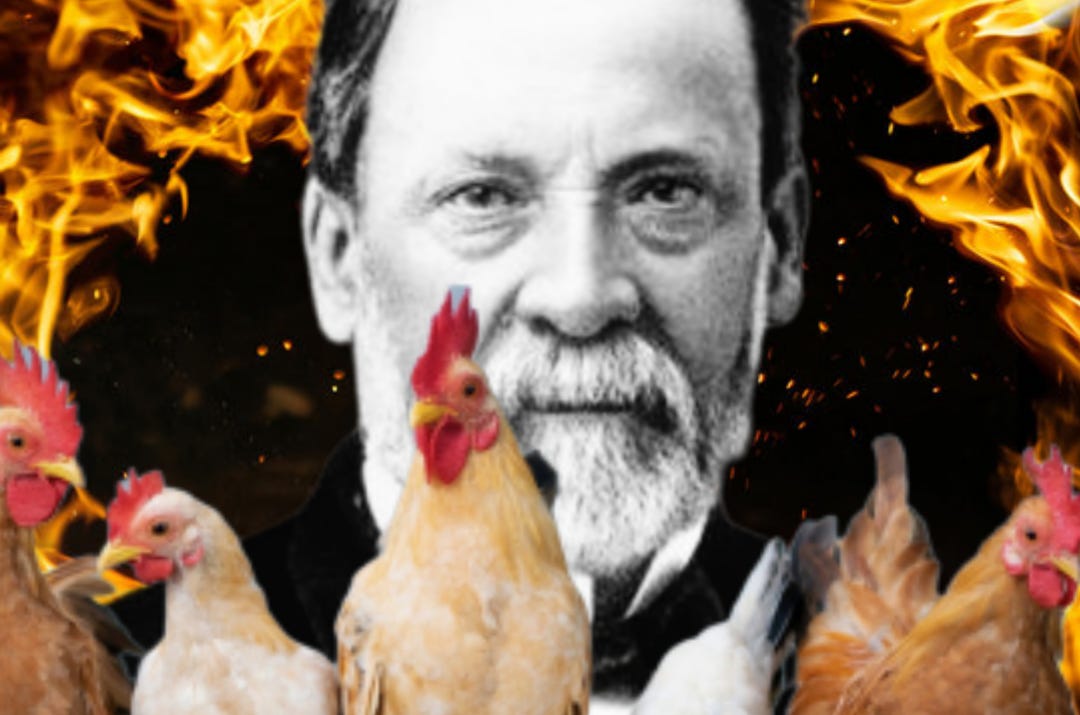
Obviously, feeding chickens diseased muscles from other dead chickens and injecting cultured broth and blood into the pecs, thighs, and skin of healthy chickens are not natural routes of exposure, and thus, this recreation of experimental disease would not be reflective of anything that could be observed in nature. These experiments did not line up with Pasteur’s hypothesized natural exposure route of the pus of guinea pigs contaminating the feed. Thus, the proposed hypothesis was never tested in any way that could logically confirm or reject it. Instead, Pasteur employed unnatural methods where chickens cannibalized other chickens or were injected with substances in ways that they would not be subjected to in nature, thus invalidating the evidence presented.
However, this isn’t the most damning revelation. In the 1882 paper Pasteur’s Experiments by Rollin Gregg, M.D., a fatal flaw was pointed out regarding the assumptions made by Pasteur and other researchers studying chicken cholera and related diseases. They were mistaking coagulated fibrin as living microorganisms.
“This brings us then to one of the most important of all questions, for a better and more scientific understandiug of this subject, and that is: What are these microbes? Prof. Pasteur says they are living organisms, bacteria, or vegetable parasites, and all investigators and writers, not only upon these diseases, but on diphtheria as well, assert the same. But have not all such observers overlooked one ever-present and very important fact in all these and similar cases, and that the fact, that in every instance where blood congests, as the result of their inoculation, the fibrin in the blood of the animal inoculated commences at once, or soon, to coagulate, locally at first, and then more or less throughout the whole system, into minute granules as the result of the poison introduced; and that these minute granules of fibrin have been mistaken by them for living organisms, or vegetable parasites?”
Dr. Gregg went on to say that these fibrin particles appear indistinguishable from the forms of bacteria that had been discovered at the time, and that injecting coagulated fibrin into healthy chickens causes the same coagulation to occur within them leading to disease.
Again, it should be borne in mind, that the molecular granules; the fibrils and spirals of coagulating fibrin, are, in their very appearance, and under all circumstances, precisely like the three classified forms* of bacteria, spherical, rod-like and spiral (the microscope has never pointed out the slightest distinction between them), and that they occupy the same positions and demean themselves in precisely the same manner wherever found.
Therefore, if Prof. Pasteur will repeat his highly important experiments, recently reported in London, and while doing so, keep well in view the foregoing facts, he will no doubt be led to revise his conclusions, from seeing that his microbes, or bacteria, of chicken cholera, and of splenic fever, are simply coagulated particles of fibrin in the blood of the diseased animals, and that those caused in healthy animals by their inoculation with such blood, are also nothing but coagulating particles of the fibrin of their blood—the coagulation thereof being simply induced in the healthy animal by like matter, coagulated fibrin, in the diseased animal’s blood, introduced by the inoculation.”
Dr. Gregg then criticized Pasteur for assuming and asserting the presence of unnatural elements within the blood without proof while ignoring a natural element in fibrin that can be proven easily. He then challenged Pasteur to prove his burden of an unnatural element, or the natural explanation should take its place.
“He assumes and asserts the presence of an unnatural and foreign element, vegetable organism, in the blood, etc, without clear proof that they are such, while we can positively assert and prove the actual presence of a normal element, fibrin, there, but morbidly changed, that is, coagulated into minute particles, by the inoculating poison, or by the inflammation which that excites. Therefore, I repeat, the burden of proof lies wholly with him to make good his unnatural claim, or the natural fact must and should take its place.”
Based upon Dr. Gregg’s account, we can see that it was a misinterpretation of what Pasteur witnessed within the blood, as well as the unnatural experimental mode of injection, that led to disease. This had absolutely nothing to do with how a chicken would acquire the disease in nature or Pasteur’s hypothesized natural exposure route. Thus, Pasteur’s experiments failed as an explanation of an observed relationship of a natural phenomenon. Ironically, even Robert Koch rejected some of Pasteur’s experiments as worthless and naive, particularly ridiculing his work with chicken cholera.
Regardless, based upon his experimental evidence with the bacterium, Pasteur was eventually credited with creating an attenuated vaccine for chicken cholera in 1880, which some consider as the birth of “immunology.” However, there is controversy over how this came about. As legend has it as told by Pasteur’s most trusted partner Emile Duclaux and recounted in his semi-autobiograpghy written by his son-in-law Rene Vallery-Radot, a virulent culture of Pasteurella that killed injected hens was forgotten about by an assistant and left on the bench during Pasteur’s vacation in the summer of 1879. Upon his return, Pasteur used this old bacterial culture to inject the hens and was surprised to find that it failed to kill them. He then prepared a fresh virulent culture and injected it into the same hens, which did not result in the death of the hens as expected. From that observation, Pasteur assumed that the bacterium, when exposed to the air, lost its “virulence,” allowing for it to be used as a vaccine. He would go on to state, “In the fields of observation, chance favors only prepared minds.” In other words, the creation of the vaccine was a happy coincidence. Interestingly, Pasteur would not go on to reveal the methods for how he was able to develop this vaccine until late October of 1880, nine months after he had announced his successful creation of the vaccine. According to Geison, at that time, Pasteur provided no explanation as to why exactly oxygen should weaken microbes, especially the aerobic microbes that depended on it for life. Perhaps this delay in explaining his vaccine is due to the fact that, when he made his announcement, it was still an inconclusive program of research and the means had not yet been fully established through decisive experiments. In other words, Pasteur simply had no explanation, and the story concocted at a later date was nothing but pure fiction.
To support this contention, in 1878, Pasteur instructed his son-in-law to never allow his lab notebooks to be released to the public. However, nearly 100 years later in 1964, his grandson, Professor Louis Pasteur Vallery-Radot, donated all 152 notebooks to the French National Library. This allowed historians, such as Gerald Geison, to comb over Pasteur’s work, and upon doing so, it was revealed that within his notebooks, there was no text between July 1879 and November 1879 mentioning this “fortunate” event that resulted in the attenuation of the culture. However, on January 14th, 1880, Pasteur wrote in his lab book: “Hen’s germs: when should we take the microbe, so it could vaccinate?” He would go on to announce the discovery of the vaccine in February of 1880. This was a clear admission that Pasteur had no understanding of the vaccine when he was said to have performed the experiments the year prior. Pasteur had lied about the events leading up to the creation of the vaccine. While he is still given credit for proving the causative agent and for demonstrating the effectiveness of the vaccine, even Pasteur noted in his 1881 paper that, as the result of many experiments, “the effects of vaccination are very variable,” and that vaccines “rarely act as a complete preventative.” Nearly 100 years later, in the 1959 paper Studies on Control of Fowl Cholera, we find out that the effects weren’t just variable, but that vaccination was ineffective against the disease and that it provided no protection to the vaccinated flock, making it an unreliable method to control disease.
“Although Pasteur in 1880 demonstrated immunity in fowls inoculated with attenuated cultures of P. multocida, workers since that time have had irregular results with various vaccines and bacterins. Generally, no protection was provided in the vaccinated fowls, or the resulting immunity was of a low level and of short duration. Immunization has never been accepted as a dependable control measure for fowl cholera.”
Thus, from Pasteur’s first attempt to prove his germ hypothesis:
- The experiment did not reflect his hypothesis as to how the disease spreads.
- The agent utilized may have been nothing more than normal coagulated fibrin.
- The route of exposure of feeding chickens diseased muscles and/or injecting the blood of diseased chickens into healthy ones was not a natural exposure route.
- The act of injecting coagulated fibrin into a healthy animal can cause disease.
- The vaccine, used as proof of his success in identifying the causative agent, was ineffective and unsuccessful despite claims stating otherwise.
- Pasteur fabricated the account of how the attenuated vaccine came to be created.
Rabies
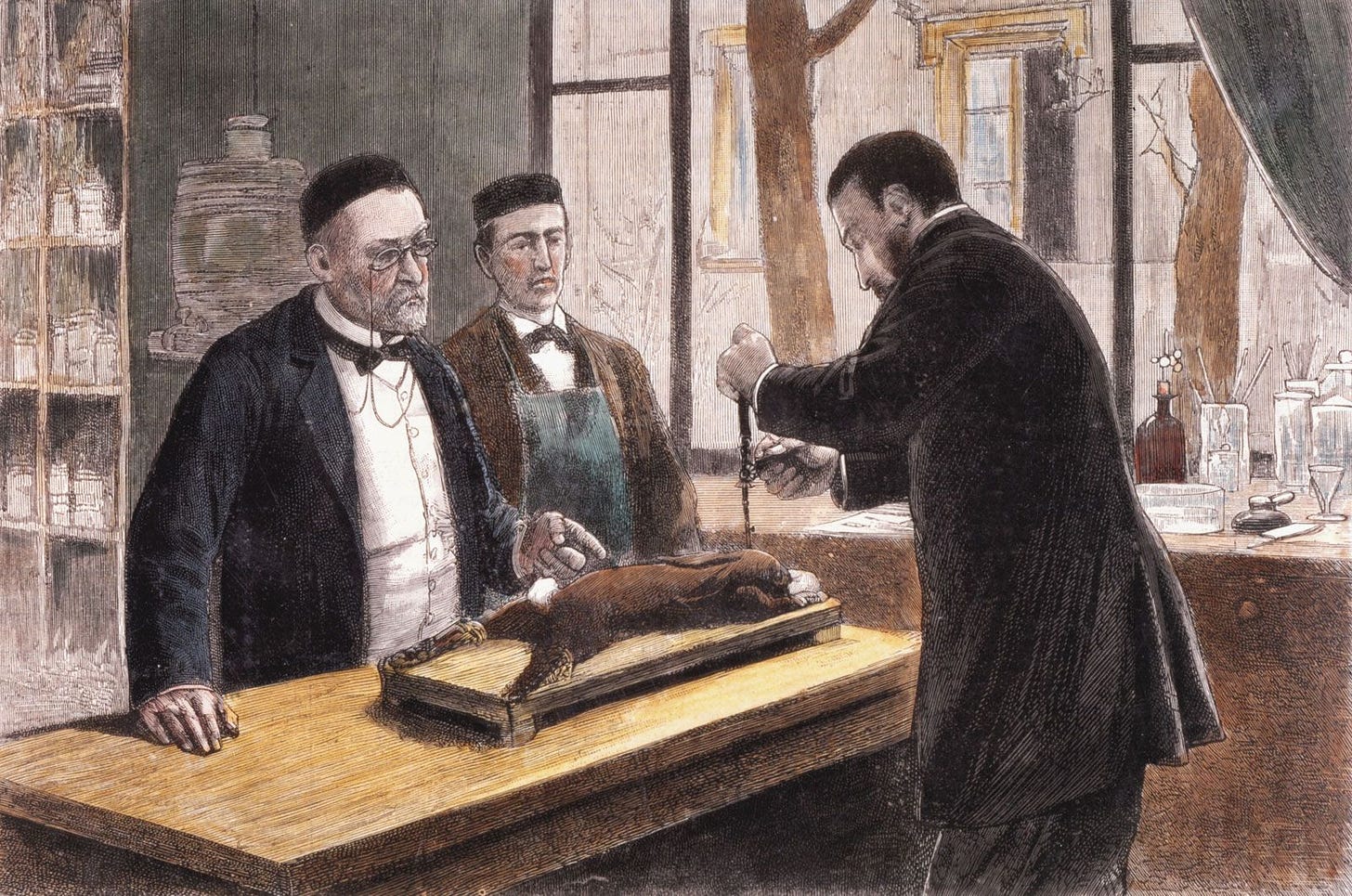
While the first attempts to prove his germ hypothesis with chicken cholera were devoid of scientific validity, Louis Pasteur is most famously known for “proving” his hypothesis with his experiments on rabies which resulted in the creation of a rabies vaccine. The idea that the bites of animals led to disease was not a new one at the time that Pasteur began his investigations into rabies in 1880. However, it was an idea that had been imprinted in his mind at the young age of eight due to a wolf attack that occurred in his hometown in 1831. As recounted by Geison, some of the victims of the attack had come to the blacksmith shop in his neighborhood, and it was there where the young Pasteur heard the screams of the men as their wounds were cauterized, which was the “cure” for rabies at that time. Later in his life, Pasteur would ask the Mayor of his town to investigate if the eight victims who died were bitten in the hands and face, while those who survived had been bitten in clothed areas. The result of this inquiry into the event that had transpired 50 years prior told Pasteur that he was on the right track with his hypothesis that the causative agent was within the saliva of the rabid animals. Geison noted that this hypothesis was supported by most students of rabies who had long since agreed that the disease was caused by a poison (or “virus”) transmitted from the saliva of the attacking animal, even though it was admitted that this alleged “virus” eluded detection and its lethal work “remained long invisible and intangible.”
While that event from his childhood may have had an impact on Pasteur’s ideas on the cause of the disease, it apparently was not the reason that he began his investigations. Geison noted that, in his private correspondences, Pasteur would insist that he had began his studies on rabies “only with the thought of forcing the attention of physicians on these new doctrines,” thus acknowledging that, at the time, his germ “theory” of disease and the technique of vaccination by way of attenuated cultures, was still very much a controversial topic. According to Pasteur confidant Emile Roux, “he thought that to solve the problem of rabies would be a blessing for humanity and a brilliant triumph for his doctrines.” Granted, there was another factor that most likely contributed. During the early 1880s, Pasteur was receiving 10 percent or more of the annual governmental expenditures for all scientific research in France, and the vaccination business was becoming very lucrative for him. By mid-1880, Pasteur and his laboratory were enjoying a net annual profit of 130,000 francs from the sale of anthrax vaccines. Geison pointed out that, in further unpublished correspondences, there was compelling evidence that Pasteur was interested in profiting from vaccines. As he was already benefitting from the vaccines he had created for animal diseases, taking a stab at creating them for human diseases was the next best option.
The rabies investigation began on December 10th, 1880, when Pasteur used a painters pencil to obtain the mucus from the mouth of a deceased 5-year-old boy who was said to have died of rabies. He mixed the mucus with ordinary water and injected this mixture into two rabbits. Within thirty-six hours, both rabbits had died, and Pasteur would use the blood from these two rabbits over the next few weeks to produce similar symptoms in healthy rabbits and dogs. Upon doing so, he associated his new microbe with the one that he had observed with chicken cholera, while claiming that this new one had different physiological properties and pathological effects. However, while Pasteur referred to his discovery in his notebooks as the “microbe of rabies,” it was said to produce a strikingly different clinical picture from that of “ordinary rabies” in both symptoms and in the rapidity with which the rabbits and dogs died. He would then go on to find the new microbe in the saliva of healthy adults as well as in victims of diseases other than rabies. Regardless, in June 1881, Pasteur announced the creation of a vaccine for this “saliva microbe” that he had decided was entirely harmless to humans even though it was lethal when injected into rabbits or dogs.
Robert Koch was particularly harsh about Pasteur’s methods, criticizing the French chemist for assuming that all “infectious diseases” are parasitic and caused by microbes, and attacking him for looking for the causative microbe in the wrong place, i.e. the saliva rather than the sublingual glands. He noted that the saliva is full of bacteria, and that even healthy people have “pathogenic” bacteria in their saliva. Koch accused Pasteur of utilizing impure materials and scolded him for beginning his experiments with the wrong test animal in rabbits rather than dogs when attempting to prove that his saliva microbe caused the rabies disease as seen in dogs.
“First, Pasteur assumes that all infectious diseases are parasitic and caused by microbes. Apparently, he regards it as unnecessary to establish the presence and distribution of microorganisms in the body–the first of the conditions that I have mentioned. Thus, Pasteur made no claims about discovering a specific microbe in the organs, particularly in the sublingual glands, of the child who died of what Pasteur called the nouvelle maladie de la rage. Yet these glands provided the point of departure for his infection experiments. Precisely in this case, such an investigation is absolutely essential because it is known that the sublingual glands contain infectious material for rabies. Moreover, since these tissues do not ordinarily contain bacteria, they would be the most likely place to discover the supposed microbes in their purest form. But in his attempt to transmit rabies from the corpse of the child, Pasteur used saliva rather than the tissues of these glands. Saliva is known to contain many different bacteria. [Edme-Felix-Albert] Vulpian and (George Miller] Sternberg have shown that even saliva from healthy persons contains pathogenic bacteria.”
“Pasteur began with impure material, and it is questionable whether inoculations with such material could cause the disease in question. But Pasteur made the results of his experiment even more dubious by inoculating, instead of an animal known to be susceptible to the disease, the first species that came along–the rabbit. To determine whether some substance contains rabies poison, one must first inoculate dogs. Suppose one is exploring the etiology of some new horse disease. Even if one inoculates with nose slime, which is certain to be contaminated by other bacteria, rather than with blood or spleen tissue, one must at least use horses as test animals. No one knows whether rabbits can even contract horse typhoid fever or what symptoms they would have if they did.”
This example from Pasteur’s early rabies attempts show how his “defective methods,” as Koch bluntly put it, led him to believe, through the recreation of disease with injections of certain materials into healthy animals, that he had found the “rabies microbe.” However, Pasteur eventually came to the conclusion that it was not the right microbe, and yet, he still created a vaccine for the experimental disease that he had created himself through his own questionable methods. Regardless, this experience, along with his subsequent lack of success to produce the exact symptoms of disease associated with rabies utilizing the saliva or blood of rabies victims, the very liquids he had hypothesized was where the rabies microbe could be found, led him to focus on the brain tissue of rabies victims instead. This was confirmed in Pasteur’s semi-autobiography The Life of Pasteur written by his son-in-law Jean Vallery-Radot:
“Hydrophobia might evidently be developed by the inoculation of saliva, but it could not be confidently asserted that it would.”
“But the same uncertainty followed the inoculation of the saliva; the incubation was so slow that weeks and months often elapsed whilst the result of an experiment was being anxiously awaited. Evidently the saliva was not a sure agent for experiments, and if more knowledge was to be obtained, some other means had to be found of obtaining it.
Magendie and Kenault had both tried experimenting with rabic blood, but with no results, and Paul Bert had been equally unsuccessful. Pasteur tried in his turn, but also in vain. “We must try other experiments,” he said, with his usual indefatigable perseverance.”
In his future studies, Pasteur would use the brain and nervous tissues from diseased animals and inject that into the brain of healthy animals in order to try and recreate the disease, particularly nervous system disorders and hydrophobia, with the goal of killing the animals faster.
“Inoculation with saliva was found to be a method which did not always produce rabies and symptoms did not declare themselves for months. The theory that the disease virus attacks the nerve centers had already been set forth by Dr. Dubous of Paris. Pasteur accordingly inoculated a number of animals subcutaneously with some of the brain substance from other animals which had died of rabies. Most of those inoculated developed rabies, but not all.
Pasteur then conceived the idea of introducing into the brain of experimental animals some of the nerve tissue from an animal which had died of rabies. This experiment was based on the principle of providing the causal organisms with the nutritive medium best suited to their requirements. Pasteur, obliged to sacrifice so many animals, had a real dislike for vivisection; if the animal cried out a little he was full of pity. The idea of perforating the skull of the dog was repulsive to him, he wanted it done but dreaded seeing it done. So it was done one day when he was away. The next day when he was told of the intra-cranial inoculation he was moved to pity for the poor dog.”
https://www.jstor.org/stable/3410286?origin=crossref
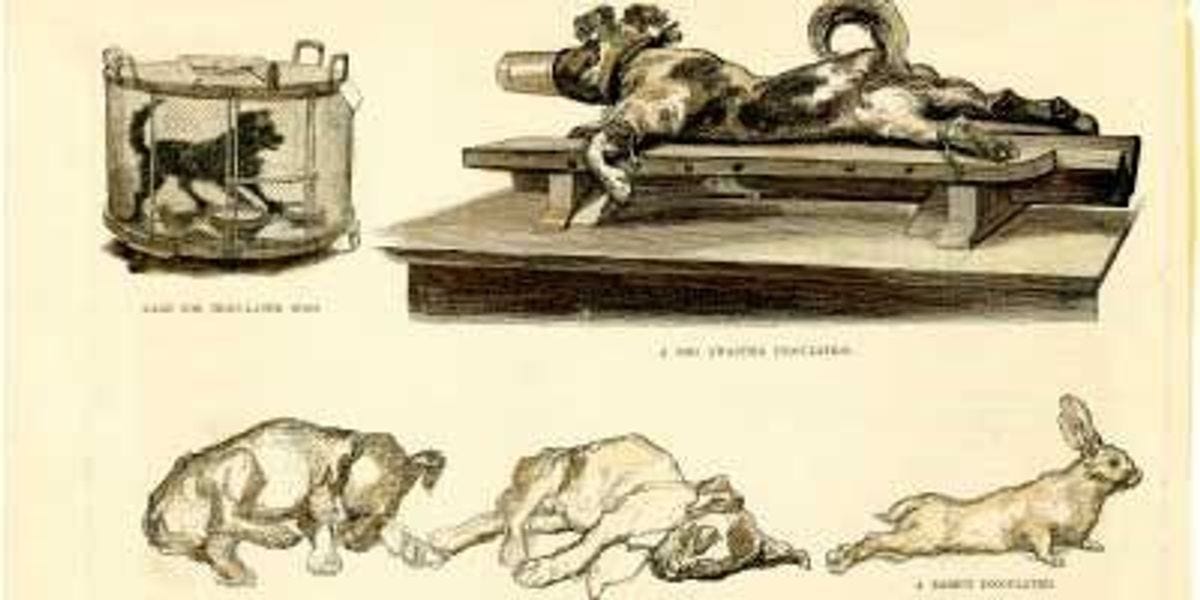
Pasteur recounted his process in gruesome detail to Jean Vallery-Radot:
It was then that it occurred to Pasteur to inoculate the rabic virus directly on the surface of a dog’s brain. He thought that, by placing the virus from the beginning in its true medium, hydrophobia would more surely supervene and the incubation might be shorter. The experiment was attempted: a dog under chloroform was fixed to the operating board, and a small, round portion of the cranium removed by means of a trephine (a surgical instrument somewhat similar to a fret-saw); the tough fibrous membrane called the dura-mater, being thus exposed, was then injected with a small quantity of the prepared virus, which lay in readiness in a Pravaz syringe. The wound was washed with carbolic and the skin stitched together, the whole thing lasting but a few minutes. The dog, on returning to consciousness, seemed quite the same as usual. But, after fourteen days, hydrophobia appeared: rabid fury, characteristic howls, the tearing up and devouring of his bed, delirious hallucination, and finally, paralysis and death.
According to Geison, Pasteur’s basic procedure was “simply to inject a variety of experimental animals—though mainly rabbits—with a wide range of cultures or substances and then watch what happened.” While he was able to experimentally recreate disease by the method of injecting the brain and neverous system materials of diseased animals into the brains of healthy animals, this in no way reflected how any animal would acquire the disease in nature. It also did not line up with his hypothesized mode of exposure through the saliva and/or blood of a rabid animal entering the wounds of its victims.
On top of his failure to recreate the disease as seen in nature via his hypothesized mode of “infection,” Pasteur was unable to ever isolate any microbe that he could attribute to the disease, as recounted by Vallery-Radot.
Pasteur could not apply the method he had hitherto used, i.e. to isolate, and then to cultivate in an artificial medium, the microbe of hydrophobia, for he failed in detecting this microbe. Yet its existence admitted of no doubt; perhaps it was beyond the limits of human sight.
Geison noted that Pasteur always supposed that a rabies microbe must exist, and he tried repeatedly to isolate it. In his laboratory notes are accounts where he thought that he had achieved his goal, but in the end, he had to admit to failing to isolate the “true rabies microbe.” Thus, we can see that Pasteur’s experiments never had a valid independent variable in any actual microbe to vary and manipulate during his studies. He assumed that one existed within the materials that he used, which, along with not fulfilling his hypothesis of a rabies microbe within the saliva, disqualifies it as a scientific experiment. The independent variable, the proposed cause, must exist prior to the experiment taking place. All that Pasteur could claim was that his process of grotesquely injecting brain and nervous system tissues taken from sick animals into the brain of healthy animals created disease. He could not claim that a specific microbe was the cause over his invasive experimental procedures with unpurified materials.
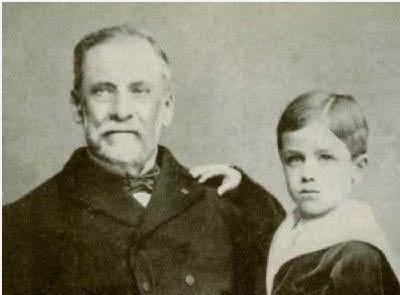
Regardless of his inability to prove his hypothesis, Pasteur went on to create a vaccine for the disease, with the first known application given to a 9-year-old boy named Joseph Meister on July 6th, 1885. According to the CDC, this was performed through a series of 14 daily injections of rabbit spinal cord suspensions containing “progressively inactivated rabies virus” into the 9-year-old, who had been severely bitten by a rabid dog 2 days before. While Meister survived the injections, Geison pointed out that Pasteur was very misleading about the claims that he made about his prior testing of the vaccine on animals that was meant to establish safety and efficacy before using it on humans. In fact, he had no evidence showing that his vaccine was safe or efficacious at all.
Meister did survive, and three months later Pasteur published a paper reporting that his rabies vaccine had previously been tested on 50 dogs without a single failure before he used it to treat the boy. But Geison discovered through the notebooks that this was, “to put it charitably, a very misleading account.”
In fact, Pasteur had extensively tested a vaccine on dogs that used an approach that was exactly the reverse of the one used on Meister. The method he used on the boy involved injections of successively stronger doses of rabies virus. This approach was being tested on laboratory dogs at the time the human experiment was attempted, but Pasteur had no conclusive animal results to show that the technique worked.
“There was no experimental evidence for his published claims about the extent of the safety and efficacy of the vaccine in animals before the human rabies trial,” said Geison.”
The CDC admitted that the basic “Pasteur Treatment,” which was based on a brain tissue vaccine with the addition of formaldehyde, still involves immunizations given daily for 14-21 days, and it still carries the same risk of neurologic sequelae (i.e. damage to the central nervous system) as seen in Pasteur’s day. It was well-known that Pasteur’s vaccine could create the exact same disease it was meant to protect against. As noted by Geison, critics of his day alleged that Pasteur’s rabies vaccine not only sometimes failed to protect those who submitted to it, but was itself the cause of death by rabies, and they tried to make Pasteur responsible for the death of anyone who displayed any symptoms of nervous disease. In support of this, Geison noted that rabies was rare in man, and that it was not an “infectious” disease. Symptoms could take years, in some cases up to 25 years, to develop, which was unlike any other disease. Geison stated that “there is a very high degree of uncertainty in the correlation between animal bites and the subsequent appearance of rabies-even when the biting animal is certifiably rabid.” He pointed out that most victims of bites by “rabid” animals could forego any treatment and survive without any complications in the future. Vaccinating someone prior to the onset of disease meant that one can never be certain whether it was the “virus” or the vaccine that caused disease and death. The critics noted that those vaccinated against rabies now faced the possibility of dealing with a novel disease, one that Pasteur himself had created: artificial or laboratory rabies. They also pointed out that the “paralytic” form of rabies, which was considered rare in natural conditions, appeared after Pasteur’s treatments, and that the use of a neurotropic vaccine complicated the diagnosis in any vaccinated individual who later developed nervous symptoms.
In order to defend himself against the claims that his vaccine led to rabies deaths, Pasteur pointed out uncertainties surrounding the diagnosis of rabies and noted that there was such a thing as “false rabies” cases. According to Geison, Pasteur relied on the authority of a Dr. Trousseau and cited two cases in which symptoms of the disease had been induced solely by fear.
“In one case, a man suddenly displayed several of the classic features of rabies—including throat spasms, chest pain, extreme anxiety, and other nervous symptoms—merely because the disease had become the subject of a lunchtime conversation. And this man had never even confronted a rabid animal. Presumably more common was the second case, that of a magistrate whose hand had long before been licked by a dog later suspected of rabies. Upon learning that several animals bitten by this dog had died of rabies, the magistrate became extremely agitated, even delirious, and displayed a horror of water. His symptoms disappeared ten days later, when his physician persuaded him that he would already be dead had he been afflicted with true rabies.”
Pasteur also recounted the case of an alcoholic who, after having seen some sort of deposit m his glass during lunch, “was seized by a feeling of horror toward the liquid and by a constriction of the throat, followed by headache and by lameness and fatigue in all his limbs.” Pasteur stated that this man, who succumbed a few days after developing symptoms, “displayed all the features of furious rabies,” but that the man did not die of rabies as he had never been bitten. Thus, as Pasteur ironically showed, no microbe is necessary to explain the symptoms associated with rabies.
Regardless, Geison stated that, due to his vaccine, Pasteur and his laboratory received a copious amount of donations from private individuals and organizations throughout the world. This led to the organization of a formal subscription where contributions easily surpassed two million francs by November 1888, the same time that his new Institut Pasteur was officially inaugurated. To say that the creation of a rabies vaccine was lucrative for Pasteur is an understatement. To say that he proved his hypothesis that a specific microbe could cause the rabies disease and that his vaccine prevented the disease from occurring is nothing but pseudoscientific fiction. Pasteur was unsuccessful in culturing and identifying any microbe responsible for rabies from the saliva, blood, and neverous system tissues from diseased animals. However, he still believed that, despite the absence of having an isolated pathogen, creating a successful vaccine would prove that his germ “theory” was true. Due to his secrecy surrounding his work, Geison noted that debate raged over “whether or not his work on rabies met the standards of truly scientific research.”
Thus, from his forray into rabies, we find that Pasteur clearly failed at proving his hypothesis of a specific microbe as the causative agent as he:
- Was unable to isolate any microbe responsible for the experimental disease that he produced.
- Showed that his methods brought about unrelated artificial disease not seen in nature with injections of cultures of microbes, which could then be used to make vaccines for his newly created artificial disease.
- Performed grotesque unnatural injections of nervous tissues into the brains of animals to recreate nervous system disease which did not reflect his hypothesized route of exposure.
- Concocted a rabies vaccine that produced the same signs and symptoms of disease it was supposed to protect against, and even those not seen in nature, which could lead to death.
- Admitted that the rabies disease could occur without animal bites or any “pathogenic microbe” due to fear and drug abuse.
Lack of Support
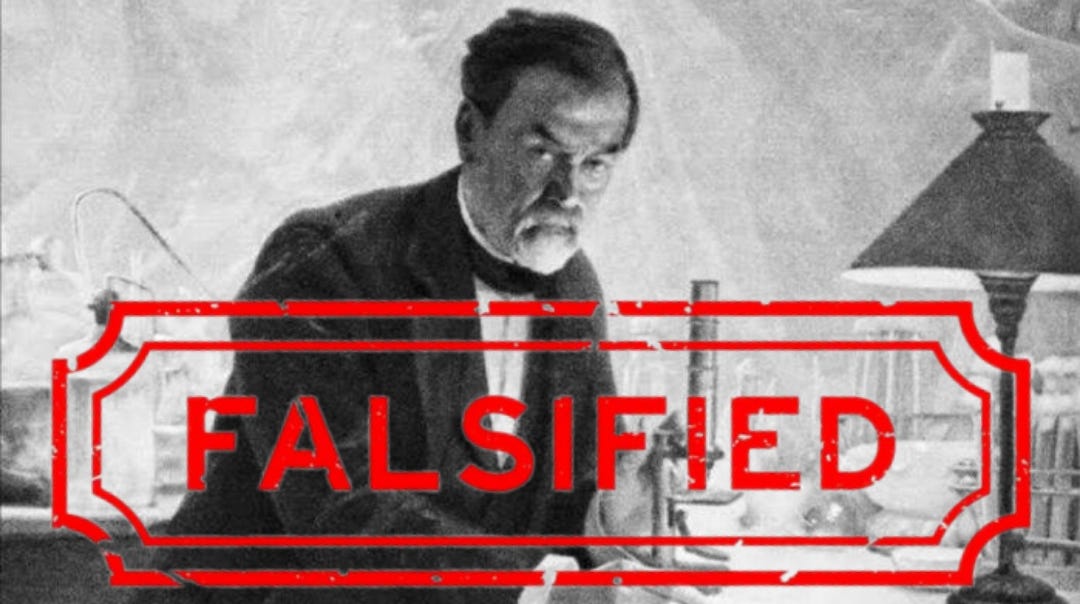
As discussed, the purpose of the hypothesis is to propose an explanation for an observed natural phenomenon that can be tested and confirmed through experimentation in order to gain knowledge about natural events or processes that occur within nature. The experiments and evidence generated to support said hypothesis should reflect the observed natural phenomenon. In no way did Louis Pasteur provide any evidence that could be said to be close to achieving this. To “prove” his hypotheses, Pasteur fed chickens the remains of diseased chickens, injected animals with coagulated substances into the muscles and skin and drilled holes into the heads of dogs and injected them with diseased brain and nervous system matter. None of these methods of exposure reflect any event or process that was observed in nature. Why did Pasteur have to resort to such grotesque methods in order to create experimental disease if his hypothesis was correct that the natural exposure to germs themselves were the cause of the disease? It is because exposure to microbes through a natural route, either aerosolized or with pure cultures applied to their regular feed, did not produce disease. Thus, unnatural and invasive methods that did not reflect nature had to be substituted in place until the desired results were created. Therefore, the actual proposed hypotheses for how the diseases were said to occur in nature were falsified by the repeated failures to recreate the disease naturally in said manner. Based upon the work of Louis Pasteur, the germ hypothesis was disproven from the very beginning, and it should have never been elevated into the status of a scientific theory.
Regardless, the work of Pasteur’s contemporary and bitter rival, the German bacteriologist Robert Koch, ultimately provided a lifeline to Pasteur’s disproven germ hypothesis. As Koch’s work was instrumental in elevating the falsified hypothesis to its status as a scientific theory, we will examine his contributions in Part 2. We will explore whether Koch’s experimenal results, combined with his revolutionary methods and logical postulates, were enough to overcome the fatal flaws of Pasteur.
This article originally appeared on ViroLIEgy’s Antiviral Substack.
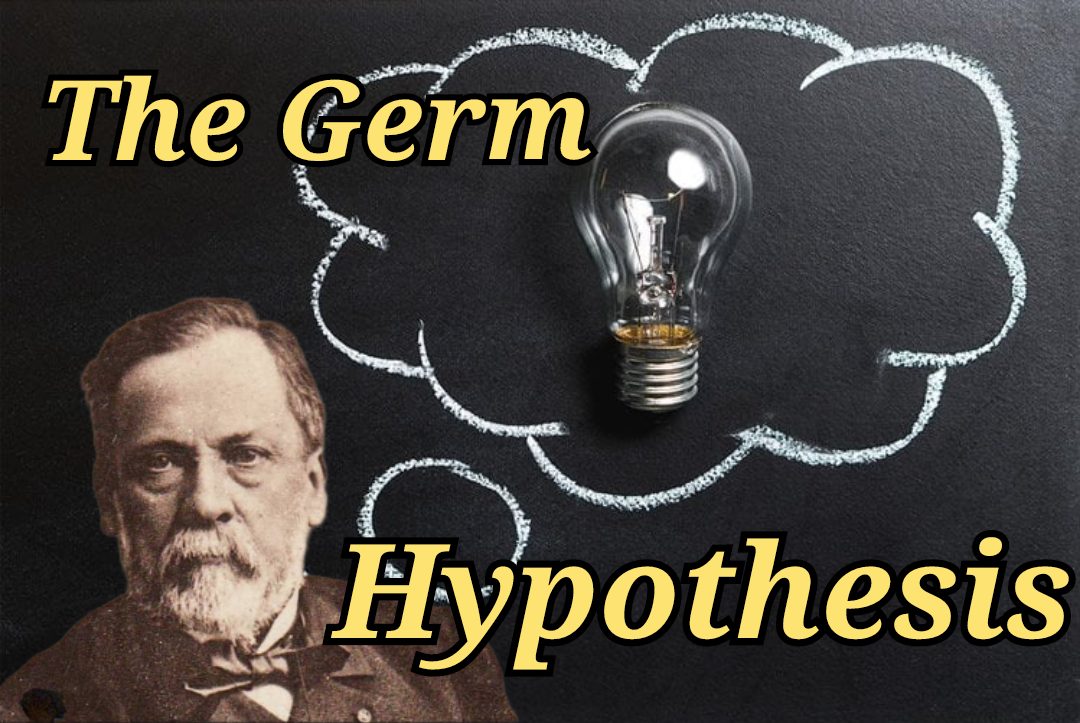
In the atmosphere of C19th science there was a divide between the ‘sponteparists’ and the ‘vitalists’. I think this reflects the enduring dualist legacy of the materialist outlook generally in that, like Pasteur, we cannot accept the idea that what we believe, and our ethical systems, are related to the ‘material’ functions of the body and nature generally. This explains how pasteur probably believed vigorously in the genius of his work. What it also implies, like many othe aspects of modern materialist culture, is that we seek to find an outside cause for the problems caused, in reality, by our own behaviour and attitudes.
LikeLiked by 1 person
Yes – but our behaviours and attitudes extend or are derived from accepted thought, (conscious or not), so the root of the split mind that gives rise to a conflicted and conflicting outcome is at the level of our self-belief, image or definition. Not merely as a set of images or concepts, but as identity drawn from or framed in such a ’cause’. Always an alloy of love & fear or love in a frame of fear that seeks to mask or pass off as love, caring or justified in withdrawal or withholding of love.
In other words I agree with you and also that the root of this is in human consciousness rather than selected persons, groups of ideologies.
Framing self and life in our own making rises from a sense of lack-driven solution, rather than the gift or effulgence of our very being and of a quality that embraces self and other and world.
I recently read Herbert Butterfield’s The Origins of Modern Science. Despite being written in the mid 50’s – it remains a valid example of seeking to understand or appreciate the unfoldment of happenings in the context of their time – and not just as a support or significance for who we present or claim to be, now. Such as victims of pathological genetic hackers – compelled to countermeasures!
There is always another way of seeing this (relationship, even or situation) – and that extends through time and space to open a greater presence – as we are willing to receive by sharing in.
LikeLiked by 1 person
The European nationalism of that era was a driving force for rivalry competition and war – to which science is fitted or bent as support.
I read but cant recall where – maybe Lanka – that in order to deny ports to the British shipping, claims of plague were spread as psyop – bolstered by the weaponised (but known to be false ‘science’ of germ theory).
In one way or another the USE of thescience as an invocation of authority for false claims targeted to war or market capture was ‘too useful’ or too invested in, to be allowed to fail. If the function is possession and control, then seeking gain by war generates the fictions that are most likely to work in the belief system of the target. This becomes the grooming of targets by mainstreaming social fictions set in ritual responses woven in the social fabric.
The identity of social inclusion or exclusion is life and death. We do have mitigated versions – as in being cancelled or blacklisted, but the principle and practice of scapegoating as the means to maintain social order is ancient – yet false – as the attempt to get rid of denials and conflicts onto others and world operates a reductive depletion to structures of hollow ‘controls’ through which the denials operate through the unwitting as a world of limitation, conflict, sickness, pain and loss. This is fuelled BY attempts to overcome, escape or otherwise psychically redistribute it in shifting narrative identities.
LikeLiked by 1 person
“Growing light, however, brings with it increasing responsibility, and the “ignorance” that may be “overlooked” at one stage of the history of men and nations may be blameworthy and even criminal at another.” – W. L. Walker
LikeLiked by 1 person
NEW PCR LIE FOR A NEW PANDEMIC — BRING ME THE SAMPLE, I’LL FIND THE PANDEMIC
https://www.bitchute.com/video/I2ni26Js8qBo/
LikeLiked by 1 person
Here’s the latest scam with “viruses.”
A new way to see viruses in action: Super-resolution microscopy provides a nano-scale look
https://phys.org/news/2024-05-viruses-action-super-resolution-microscopy.amp
LikeLiked by 1 person